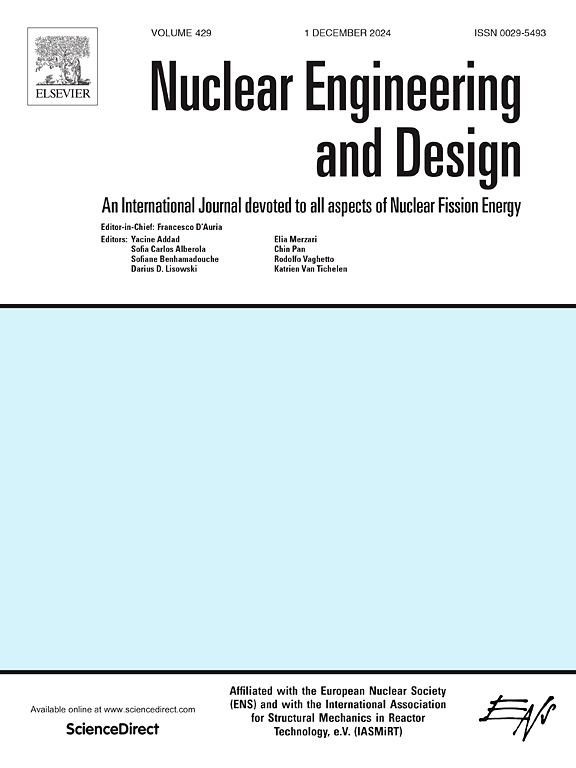Evaluating the benefit of thorium in a two-zone thermal molten salt reactor using open fuel cycle
IF 1.9
3区 工程技术
Q1 NUCLEAR SCIENCE & TECHNOLOGY
引用次数: 0
Abstract
Thorium is a promising alternative fuel to uranium. Unlike uranium, thorium can attain breeding condition in thermal neutron spectrum. This benefit can be achieved especially by using molten salt reactor (MSR), especially with its online reprocessing capability. In an open fuel cycle, however, this benefit is less clear. This study evaluates the utilisation of thorium in an MSR using open fuel cycle using OpenMC code and ENDF/B-VII.1 library. The evaluated model was based on two-zone, single fluid MSR commonly used in thermal breeder MSR. Four fuel scenarios were simulated, namely LEU-U8, LEU-Th, RGPu-U8, and RGPu-Th, based on different configurations of fissile and fertile materials. Among the analysed parameters are reactor effective full power days (EFPD), conversion ratio (CR), fuel utilisation efficiency, and minor actinide (MA) production. The LEU-U8 configuration exhibits high initial reactivity but a large reactivity swing, which shortens its EFPD. In contrast, LEU-Th demonstrates slower reactivity depletion due to the efficient conversion of 232Th to 233U. RGPu-based fuels, particularly RGPu-U8, have shorter cycles due to the large neutron absorption by 240Pu. LEU-Th and RGPu-Th attain the highest CR, indicating more efficient use of fertile fuel than their uranium counterparts. Using thorium generates lower MA waste, although the difference is small in RGPu-based fuel. Therefore, in a two-zone MSR using open fuel cycle, thorium exhibits some advantages over uranium both using LEU or RGPu as the fissile driver.
采用开放式燃料循环的两区热熔盐堆中钍的效益评价
钍是一种很有前途的铀的替代燃料。与铀不同,钍在热中子谱中能达到增殖条件。使用熔盐堆(MSR),特别是其在线后处理能力,可以实现这一效益。然而,在开放式燃料循环中,这种好处就不那么明显了。本研究使用OpenMC代码和ENDF/B-VII评估了钍在MSR中使用开放式燃料循环的利用率。1图书馆。评价模型基于热中子增殖反应堆常用的两区单流体MSR。基于不同的易裂变和可增殖物质配置,模拟了4种燃料情景,即LEU-U8、LEU-Th、RGPu-U8和RGPu-Th。分析的参数包括反应堆有效全功率日(EFPD)、转化率(CR)、燃料利用效率和次要锕系元素(MA)产量。LEU-U8结构具有较高的初始反应性,但反应性波动较大,缩短了其EFPD。相比之下,由于232Th到233U的有效转化,LEU-Th表现出较慢的反应性损耗。基于rgpu的燃料,特别是RGPu-U8,由于240Pu的大量中子吸收,具有更短的周期。LEU-Th和RGPu-Th达到最高的CR,表明比铀更有效地利用肥沃的燃料。使用钍产生的MA废物较少,尽管在基于rgpu的燃料中差异很小。因此,在使用开放式燃料循环的两区MSR中,钍比使用低浓铀或RGPu作为裂变驱动器的铀具有一定的优势。
本文章由计算机程序翻译,如有差异,请以英文原文为准。
求助全文
约1分钟内获得全文
求助全文
来源期刊

Nuclear Engineering and Design
工程技术-核科学技术
CiteScore
3.40
自引率
11.80%
发文量
377
审稿时长
5 months
期刊介绍:
Nuclear Engineering and Design covers the wide range of disciplines involved in the engineering, design, safety and construction of nuclear fission reactors. The Editors welcome papers both on applied and innovative aspects and developments in nuclear science and technology.
Fundamentals of Reactor Design include:
• Thermal-Hydraulics and Core Physics
• Safety Analysis, Risk Assessment (PSA)
• Structural and Mechanical Engineering
• Materials Science
• Fuel Behavior and Design
• Structural Plant Design
• Engineering of Reactor Components
• Experiments
Aspects beyond fundamentals of Reactor Design covered:
• Accident Mitigation Measures
• Reactor Control Systems
• Licensing Issues
• Safeguard Engineering
• Economy of Plants
• Reprocessing / Waste Disposal
• Applications of Nuclear Energy
• Maintenance
• Decommissioning
Papers on new reactor ideas and developments (Generation IV reactors) such as inherently safe modular HTRs, High Performance LWRs/HWRs and LMFBs/GFR will be considered; Actinide Burners, Accelerator Driven Systems, Energy Amplifiers and other special designs of power and research reactors and their applications are also encouraged.
 求助内容:
求助内容: 应助结果提醒方式:
应助结果提醒方式:


